
See our 2019 ranking of the best canned wines here!
Canned wines< are on the march. According to a January 2018 Nielsen report, category growth outpaced any other form of wine packaging in the U.S. last year. As more brands continue to debut canned offerings, sales of the summer sippers promise to be similarly abundant.
Last summer, VinePair sampled the market-leading canned wine options and, given the category’s continued success, we thought it was high time we tried some more. One year on, we discovered a much broader selection of serving sizes, varieties, and styles, as well as some interesting insights into the category as a whole.
Canned wines’ biggest advantage continues to be their convenience. The serving size is equally ideal for weekday consumption, transport, and chilling — which is probably why the market is dominated by varieties and styles that taste better plucked from a bucket of ice.
One thing that’s important to remember when cracking open a can of wine is that the 375-milliliter serving is equivalent to half a standard bottle. While brands make their cans look and feel like craft beers, they most certainly cannot be crushed in the same way. So to help drinkers avoid losing track of alcohol consumption, many companies now offer even smaller servings (250 milliliters and 187 milliliters, respectively).
Unlike cork stoppers and screw caps, once cans are sealed, no oxygen can reach the wine within. This caused an issue in many of the wines we tasted, especially the whites. Several displayed strong reductive notes (think burnt matches and boiled eggs). The common remedy for this involves nothing more than a bit of glass swirling, but that isn’t a viable option if you’re drinking straight from the can.
Similarly, for many wine drinkers, much of their enjoyment comes from sniffing a wine’s bouquet of aromas. This, too, is best displayed after a few revolutions in a nicely sized glass, and is not an option in a can.
Even with the significant recent sales growth, canned wines still account for less than 1 percent of the domestic market value. If they are to enjoy a larger share, producers may have to make a decision as to exactly what the category represents: Are cans simply a convenient, alternative form of packaging, or is this a standalone style of winemaking? If the latter, future cannings might address these quality-control tasting issues.
In the meantime, take advantage of the increasing diversity of the category. We tasted countless cans to rank these, the 10 best canned wines you absolutely have to try this summer.
10. The Pinot Project, Pinot Noir
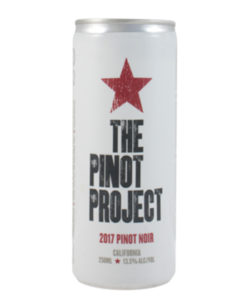 Clocking in at a whopping 13.5 percent ABV, this California Pinot is surprisingly quaffable. It’s probably a good thing, therefore, that it’s available in 250-milliliter servings — the equivalent of a large glass of wine. Displaying bright red fruit aromas and a peppering of allspice and clove, this is a refreshing red that can be enjoyed slightly chilled.
Clocking in at a whopping 13.5 percent ABV, this California Pinot is surprisingly quaffable. It’s probably a good thing, therefore, that it’s available in 250-milliliter servings — the equivalent of a large glass of wine. Displaying bright red fruit aromas and a peppering of allspice and clove, this is a refreshing red that can be enjoyed slightly chilled.
9. Dark Horse, Rosé
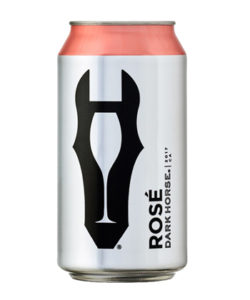 The Dark Horse rosé is light-bodied and refreshing, with a crisp finish. Made using an interesting mix of red and white varieties, it has the bouquet of an opulent English garden, including ripe summer strawberries and attractive floral notes.
The Dark Horse rosé is light-bodied and refreshing, with a crisp finish. Made using an interesting mix of red and white varieties, it has the bouquet of an opulent English garden, including ripe summer strawberries and attractive floral notes.
8. Underwood, The Bubbles
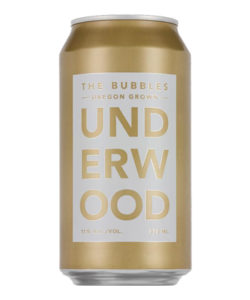 Underwood is one of the category-leading brands, boasting a broad range in attractive, minimalistic packaging. VinePair tasters particularly enjoyed The Bubbles, with its “refreshing acidity,” “clean citrus and green fruit notes,” and “crisp, lingering finish.” This is a must-try for Prosecco fans.
Underwood is one of the category-leading brands, boasting a broad range in attractive, minimalistic packaging. VinePair tasters particularly enjoyed The Bubbles, with its “refreshing acidity,” “clean citrus and green fruit notes,” and “crisp, lingering finish.” This is a must-try for Prosecco fans.
7. Nomikai, Fizzy Rosé and Red
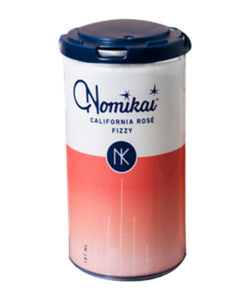 We loved the 187-milliliter serving size and savored every drop of the lightly sparkling, pink-grapefruit-scented beverage. If you say “No way!” to rosé, Nomikai also offers an equally enjoyable Merlot-driven red — a welcome departure from Pinot Noir, which otherwise dominates the canned red category.
We loved the 187-milliliter serving size and savored every drop of the lightly sparkling, pink-grapefruit-scented beverage. If you say “No way!” to rosé, Nomikai also offers an equally enjoyable Merlot-driven red — a welcome departure from Pinot Noir, which otherwise dominates the canned red category.
6. Tiamo, Rosé and Red
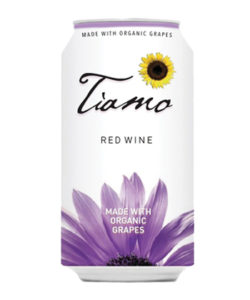 We love Tiamo’s rosé and red for three simple reaons: They’re Italian, made with organic grapes, and are lower in alcohol than much of the competition. The rosé shares many of the characteristics of others on this list: strawberry and floral aromas, crisp finish, and an added pinch of sea salt. The red, meanwhile, is made from Montepulciano, Nero d’Avola, and Syrah grapes and is classically Italian. It’s dominated by rugged herb and fruit notes, with a persistent acidity to carry it through to the end.
We love Tiamo’s rosé and red for three simple reaons: They’re Italian, made with organic grapes, and are lower in alcohol than much of the competition. The rosé shares many of the characteristics of others on this list: strawberry and floral aromas, crisp finish, and an added pinch of sea salt. The red, meanwhile, is made from Montepulciano, Nero d’Avola, and Syrah grapes and is classically Italian. It’s dominated by rugged herb and fruit notes, with a persistent acidity to carry it through to the end.
5. The Original House Wine, Rosé Bubbles
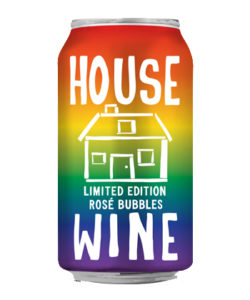 While some canned wines improve after decanting, this wine begs to be sipped straight from the can. Fruit-forward with honeysuckle notes, its off-dry sweetness is balanced by a pleasant acidity. Additionally, the Original House Wine rosé’s limited-edition rainbow design highlights an important cause.
While some canned wines improve after decanting, this wine begs to be sipped straight from the can. Fruit-forward with honeysuckle notes, its off-dry sweetness is balanced by a pleasant acidity. Additionally, the Original House Wine rosé’s limited-edition rainbow design highlights an important cause.
4. Bridge Lane, Sauvignon Blanc, Chardonnay, and Rosé
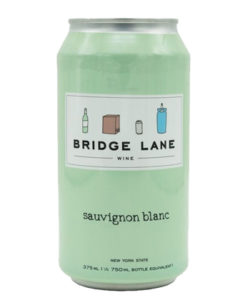 With an intense citrus and green fruit nose, this New Zealand-style Sauvignon Blanc offers everything we want in canned wine: thirst-quenching freshness and mouthwatering acidity. Bridge Lane’s Chardonnay and Rosé, too, are light, fresh, and fruity wines, cementing its position as one of our favorite canned wine brands.
With an intense citrus and green fruit nose, this New Zealand-style Sauvignon Blanc offers everything we want in canned wine: thirst-quenching freshness and mouthwatering acidity. Bridge Lane’s Chardonnay and Rosé, too, are light, fresh, and fruity wines, cementing its position as one of our favorite canned wine brands.
3. Bonny Doon La Bulle-Moose de Cigare, Rosé
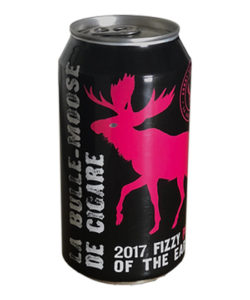 This fizzy rosé is an excellent example of how fun canned wines can be. Showing rich aromas of maraschino cherries, strawberries, and rose petals, as well as an attractive peach-pink hue, everything about La Bulle-Moose invites you to drink it. It’s perfect for food pairing, too, so be sure to stash a couple of cans in the picnic basket.
This fizzy rosé is an excellent example of how fun canned wines can be. Showing rich aromas of maraschino cherries, strawberries, and rose petals, as well as an attractive peach-pink hue, everything about La Bulle-Moose invites you to drink it. It’s perfect for food pairing, too, so be sure to stash a couple of cans in the picnic basket.
2. AVA Grace Vineyards, Pinot Grigio and Rosé
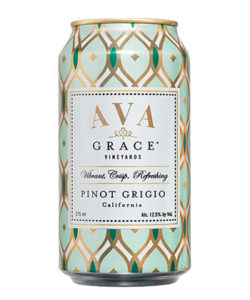 Light and refreshing, with on-point design, AVA Grace nails canned wine. The ever-so-slightly sweet Pinot Grigio is driven by citrus and green fruits, but without the eye-watering acidity to match. “It tastes mass-produced, but I don’t hate it,” one taster noted. The light-bodied rosé, meanwhile, has an attractive white peach and ripe apricot nose, which is “like a Siggi’s yogurt — it makes you think it’s going to be sweet, but is actually tart and acidic.”
Light and refreshing, with on-point design, AVA Grace nails canned wine. The ever-so-slightly sweet Pinot Grigio is driven by citrus and green fruits, but without the eye-watering acidity to match. “It tastes mass-produced, but I don’t hate it,” one taster noted. The light-bodied rosé, meanwhile, has an attractive white peach and ripe apricot nose, which is “like a Siggi’s yogurt — it makes you think it’s going to be sweet, but is actually tart and acidic.”
1. Cycles Gladiator, Pinot Noir
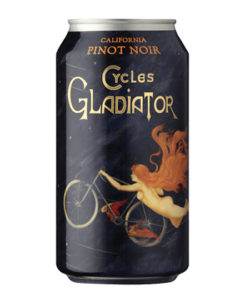 The Cycles Gladiator Pinot Noir tastes like high-quality wine served in a can, as opposed to high-quality “canned wine.” It’s a glowing example of California Pinot, with ripe cherry and plum notes and a brambly finish. There’s some oak influence, too, which seasons the wine in a skillful manner that adds character without dominating. “This wine makes me happy,” one taster noted with a smile on their face. It looks cool, too, in a renaissance painting, rather than craft beer.
The Cycles Gladiator Pinot Noir tastes like high-quality wine served in a can, as opposed to high-quality “canned wine.” It’s a glowing example of California Pinot, with ripe cherry and plum notes and a brambly finish. There’s some oak influence, too, which seasons the wine in a skillful manner that adds character without dominating. “This wine makes me happy,” one taster noted with a smile on their face. It looks cool, too, in a renaissance painting, rather than craft beer.
